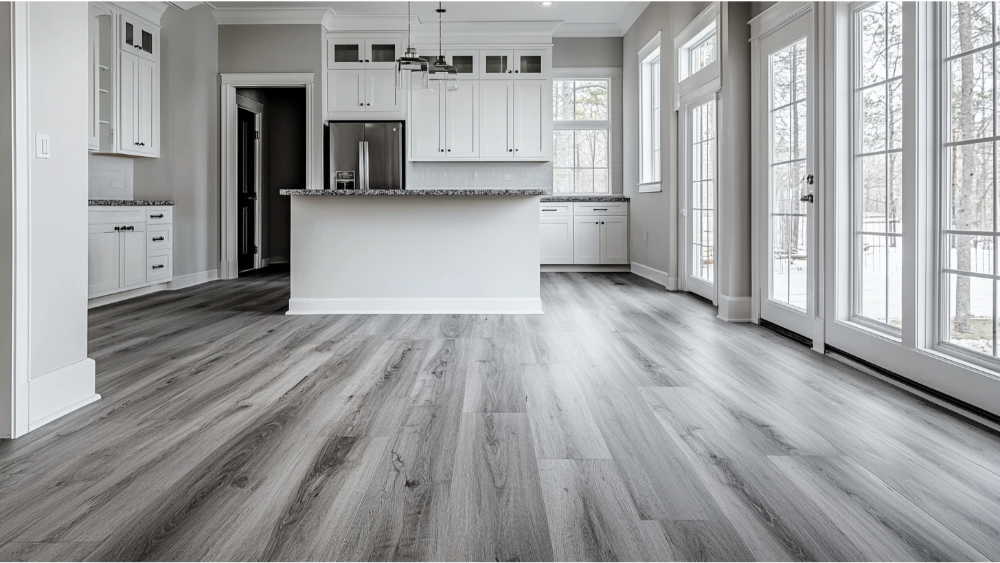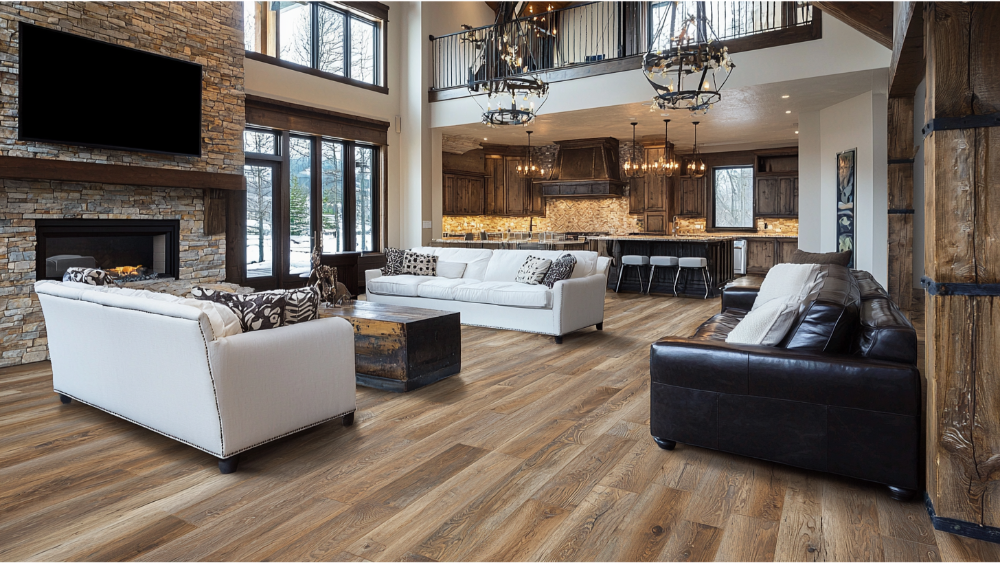Luxury Vinyl Plank (LVP) flooring is a popular choice for homeowners and businesses due to its durability, affordability, and stylish appearance. This versatile flooring option is designed to mimic the look of natural materials like hardwood or stone while offering easier maintenance and enhanced resistance to wear and tear. Understanding what LVP flooring is made of can help you appreciate its unique benefits and composition.
The 5 Layers of LVP Flooring
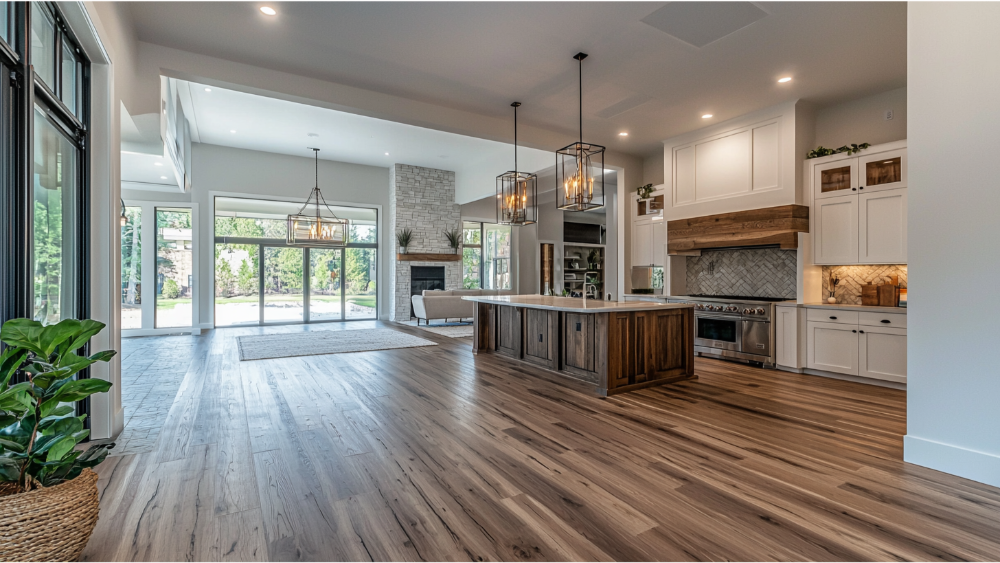
1 | Wear Layer
The wear layer is the topmost layer of vinyl flooring, designed to protect against scratches, stains, and general wear and tear. This transparent layer ensures that the vinyl plank maintains its appearance over time, making it ideal for high-traffic areas. It also adds a layer of water resistance, a significant advantage over hardwood flooring. The thickness of this layer can vary, with thicker wear layers offering increased durability and longer lifespan.
2 | Decorative Layer
Beneath the wear layer lies the decorative layer, which gives vinyl plank its realistic appearance. This layer is printed with high-definition images that replicate the look of natural hardwood flooring or other materials like stone or tile. Advanced printing techniques allow for intricate textures and patterns, enhancing the realism and appeal of the final product. This makes vinyl flooring a versatile option for achieving a stylish look without the cost of natural materials.
3 | Vinyl Core Layer
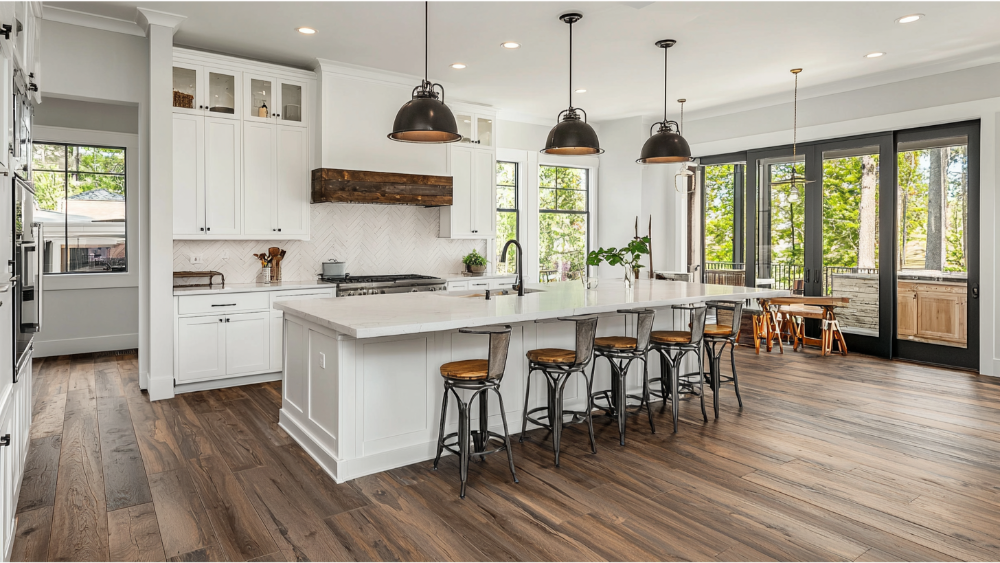
The vinyl core layer provides the structural stability and durability of the plank. Made from a resilient combination of PVC and other materials, this layer ensures that the flooring is both flexible and tough. It resists moisture better than laminate flooring, making it perfect for areas like bathrooms and kitchens. The vinyl core layer also contributes to the warmth and softness underfoot, a feature that many homeowners appreciate.
4 | Backing Layer
The backing layer is the bottom-most layer of the vinyl plank, designed for stability and additional support. Typically made from reinforced vinyl or foam, it acts as a foundation for the entire plank, improving its strength and durability. This layer also helps with sound absorption and cushioning, enhancing comfort compared to traditional hardwood flooring. The backing layer can sometimes include pre-attached underlayment for easier installation and added convenience.
5 | Underlayment (Optional)
Some LVP flooring options come with a pre-attached underlayment, while others may require a separate layer to be installed underneath. The underlayment enhances soundproofing, levels minor imperfections in the subfloor, and provides additional cushioning for greater comfort. It also serves as a moisture barrier in certain installations, protecting the flooring and subfloor from potential water damage. Choosing the right underlayment is important to ensure the performance and longevity of your LVP flooring.
Qualities That Make LVP Unique
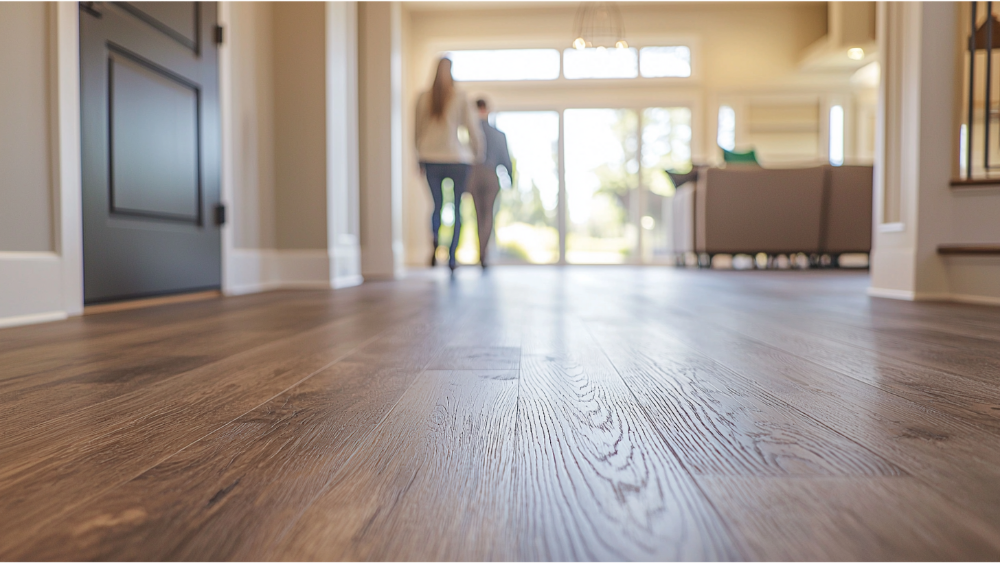
Durability and Longevity
Luxury vinyl plank flooring is designed to withstand heavy foot traffic and resist damage from scratches, stains, and dents. Thanks to its multi-layer construction, it can maintain its appearance for years with minimal maintenance. Unlike traditional flooring options, such as hardwood or sheet vinyl, luxury vinyl flooring can handle wear and tear in high-use areas like hallways and kitchens. Its durability makes it an excellent long-term investment for both homes and commercial spaces.
Realistic Appearance
One of the standout features of luxury vinyl flooring is its ability to replicate the appearance of natural wood, stone, or tile with incredible realism. High-definition printing and textured surfaces give vinyl flooring planks an authentic look and feel. Many homeowners choose LVP as a cost-effective way to achieve a premium aesthetic without compromising on quality. The flexibility in design options means you can find the perfect style to suit any décor.
Water and Moisture Resistance
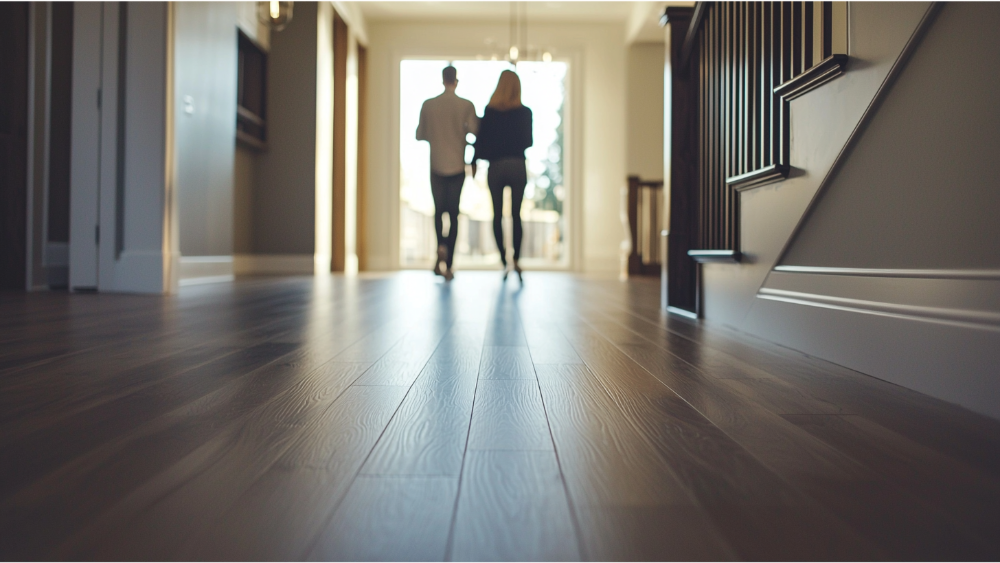
Unlike hardwood or laminate, luxury vinyl plank flooring excels in areas prone to spills and moisture, such as bathrooms, laundry rooms, and basements. Its waterproof core and wear layer make it highly resistant to water damage, giving it an edge over sheet vinyl and other flooring types. This feature also makes LVP easy to clean, ensuring that accidental spills don’t lead to long-lasting stains or warping.
Easy To Install
Vinyl flooring planks are incredibly user-friendly when it comes to installation. Many options feature a click-lock system, allowing for a straightforward, hassle-free floating floor installation without the need for adhesives. This makes LVP a favorite choice for DIY enthusiasts who want to save on professional installation costs. Additionally, its flexible nature can handle minor subfloor imperfections better than sheet vinyl, further simplifying the installation process.
Comfort and Soundproofing
Luxury vinyl flooring not only looks great but also feels comfortable underfoot due to its multi-layer construction. Many options come with pre-attached underlayment that adds cushioning and warmth while also dampening sound. This makes it a quieter and more comfortable alternative to harder surfaces like tile or stone. For spaces where comfort and quietness are priorities, such as bedrooms or living rooms, LVP is an excellent choice.
Sustainability Considerations
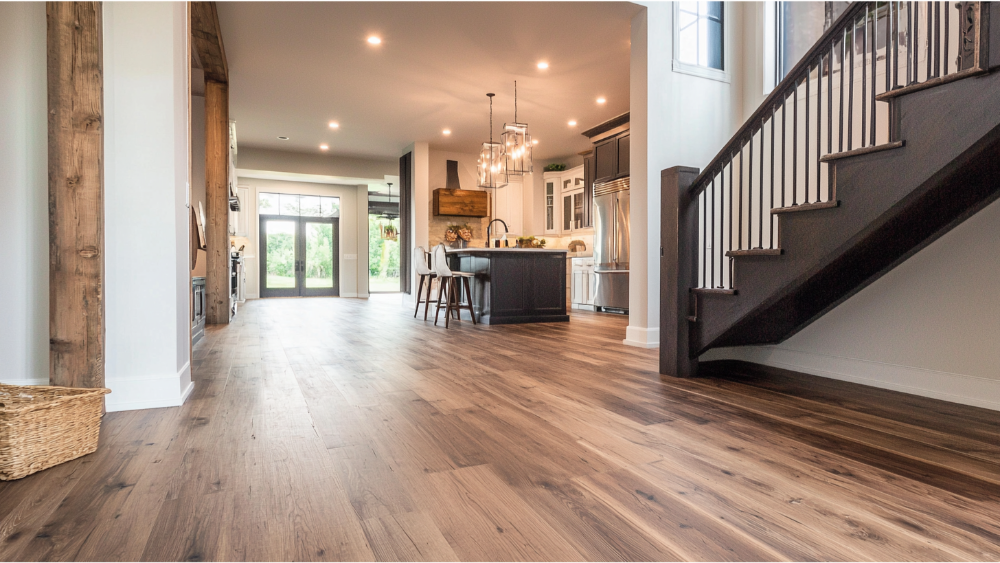
Material Composition
Luxury vinyl tile (LVT) and wood plastic composite (WPC) flooring are manufactured using a combination of synthetic and natural materials. While offering durability and aesthetic appeal, these materials require significant energy and resources during production. Opting for products made with recycled content or low-VOC emissions can reduce the environmental impact of your flooring choice.
Longevity and Waste Reduction
The multiple layers in luxury vinyl plank flooring contribute to its durability and extended lifespan, which minimizes the need for frequent replacements. Longer-lasting flooring reduces material waste and helps lower the overall environmental footprint. Choosing high-quality LVP ensures that you invest in a sustainable option that will last for many years.
Recyclability
Unlike natural stone, recycling luxury vinyl tile can be more complicated due to its composite nature. However, some manufacturers are beginning to offer take-back programs or create LVP products that are easier to recycle. Supporting these initiatives promotes a circular economy and encourages innovation in sustainable flooring solutions.
Environmental Impact of Manufacturing
The production of materials like WPC flooring and natural stone can involve high energy consumption and emissions. Opting for flooring from manufacturers committed to sustainable practices can help mitigate these effects. Look for certifications like FloorScore or GreenGuard to ensure that your LVP flooring adheres to environmentally friendly standards.
End-of-Life Disposal
Luxury vinyl tile flooring typically does not break down naturally, which makes its disposal challenging. Improperly discarded products can contribute to landfill waste over time. Exploring options such as repurposing or donating gently used flooring can make a positive environmental difference. Supporting manufacturers that offer recycling programs for vinyl flooring can help reduce its environmental impact.
Frequently Asked What is LVP Flooring Made Of Questions
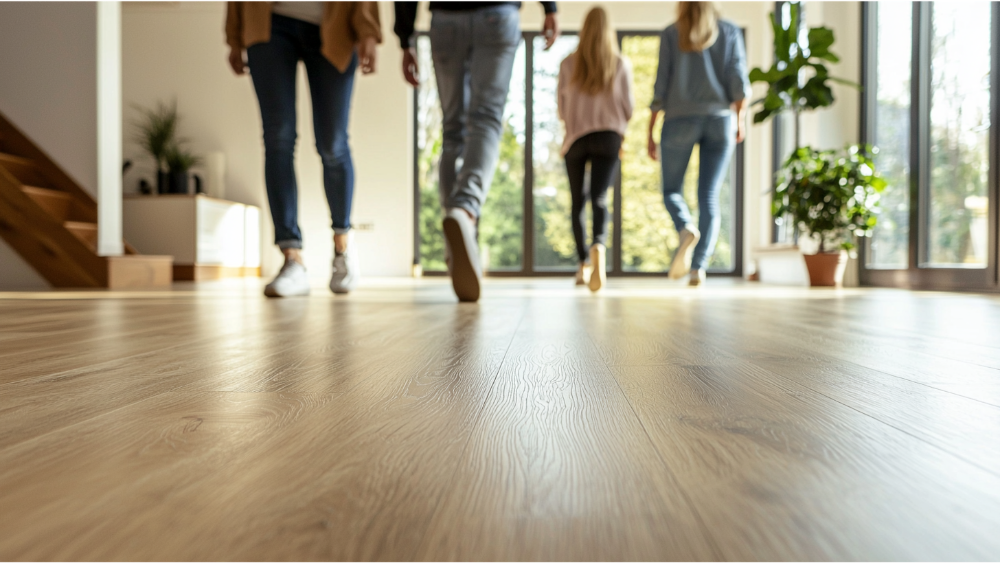
Is LVP Better Than Laminate?
Luxury vinyl plank (LVP) flooring is often seen as a better option than laminate, particularly in areas where water resistance is important. LVP’s core, made from polyvinyl chloride (PVC), gives it superior waterproof properties, making it ideal for bathrooms, kitchens, and basements.
While laminate can swell or warp when exposed to moisture, LVP remains unaffected, ensuring long-term durability. The polyvinyl chloride construction of LVP contributes to its resilience and ease of maintenance, further setting it apart from laminate flooring.
Does LVP Scratch Easily?
Luxury vinyl plank (LVP) flooring is highly resistant to scratches due to its protective wear layer, making it a durable choice for high-traffic areas. However, while it can withstand everyday use, dragging heavy furniture or sharp objects across the surface may still cause minor damage. Using furniture pads and rugs can help maintain its pristine appearance over time.
What is the Difference Between LVP and Vinyl Flooring?
The primary difference between LVP (Luxury Vinyl Plank) and standard vinyl flooring lies in their construction and appearance. LVP is designed to mimic the look of natural wood or stone, featuring thicker layers and more realistic textures compared to traditional sheet vinyl.
Standard vinyl flooring typically comes in large, flexible sheets that are thinner and better suited for budget-conscious projects. LVP often provides superior durability, comfort, and waterproof properties, making it a more premium option for modern homes.
What Destroys Vinyl Plank Flooring?
Excessive exposure to direct sunlight can cause vinyl plank flooring to fade or become brittle over time, compromising its durability. Dragging heavy furniture or sharp objects across the surface can lead to scratches or dents that damage its appearance. Additionally, harsh chemicals or abrasive cleaning tools can wear down the protective wear layer, reducing the flooring’s lifespan.
Conclusion
Luxury vinyl plank (LVP) flooring offers an exceptional combination of durability, style, and practicality, making it a go-to choice for homeowners and businesses alike. Its water resistance, ease of installation, comfort, and low maintenance needs position it as a versatile option for nearly any space in the home. While sustainability considerations and proper disposal should not be overlooked, advancements in manufacturing and recycling initiatives are paving the way for more eco-friendly alternatives. Whether you’re prioritizing aesthetic appeal, functionality, or affordability, LVP flooring provides a balanced solution that meets the demands of modern living with style and reliability.



